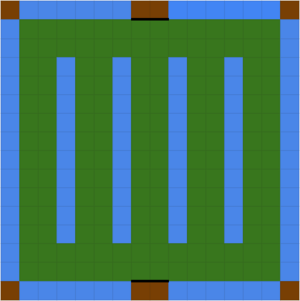Guide:Greenhouse
Location
Because moisture has such a significant effect on crop growth rate, it's beneficial to build your first farm in or adjacent to a pond or lake. If the area near spawn has mostly low fertility soil, spend awhile searching for medium fertility soil. Place soil in the pond, being careful to preserve spots of water in strategic locations.
Layout
Blocks further away from water get a lower growth rate. But a greenhouse with the maximum number of hydrated farmland isn't necessarily attractive, or convenient to use. This layout fits 156 blocks of farmland inside the 14x14x14 area and all get a passive 75% moisture rate; walls can be built over the outer ring of water.
You could use slabs on the top half of water blocks to create places to set containers and watering cans. You could store hoes and scythes on the wall in tool racks.
Bees
Bees detect flowers without a 7-block radius, regardless of walls. So you could place flowers outside the greenhouse walls and still benefit the skips inside. You could also add flowers underground or on layers of soil overhead.
Berries
Berry bushes don't need moisture or fertile soil. Currant bushes can stack 2 blocks high, so you could fit more currants in a greenhouse than cranberries or blueberries.
Materials
Once you hoe the soil, you need to hurry and implement protection against nuisance animals. A wall 2 blocks high will keep hares from getting in, but most deer can easily climb 3 blocks. If 4 blocks high, the above design uses 52 blocks (cobblestone, planks, etc), as well as 4 doors and 16 logs.
I keep the ceiling simple, with 4 sections of glass separated by beams (usually debarked logs, approx 52). Each section uses 36 glass slabs, so this design needs a total of 144 quartz chunks; use a saw to divide glass blocks into slabs. However, you can manage with significantly less glass: 98 is the minimum.
Timing
If you install glass right away, you miss opportunities for rain to speed up crop growth. If you decide to wait until winter has almost arrived, check the temperature (in C panel) at the coldest time of day: 4am. Compare with the minimum tolerance listed on the seed packet of the crops planted. If temperatures are getting close to the minimum, complete the structure and check for the +5°C in the farmland's Block Info Overlay.
Also, finishing the structure during summer puts some crops at risk of overheating. I break a block in the ceiling/wall when I want to grow heat-sensitive crops such as turnips inside, and replace the block when cooler temperatures return.
Remember, crops don't grow below 0°C. So when you're considering whether it's reasonable to plant a particular seed, compare its minimum temperature with the no-grow threshold: flax is fine until -5°C (for ambient temperatures of -10 it would be fine in a greenhouse. But it can't grow below 0°C, so finish the glass ceiling sooner than later, even if temperatures at the coldest time of day (4am) aren't cold enough to endanger flax.
The above guide by:
T.Read, July 2024
